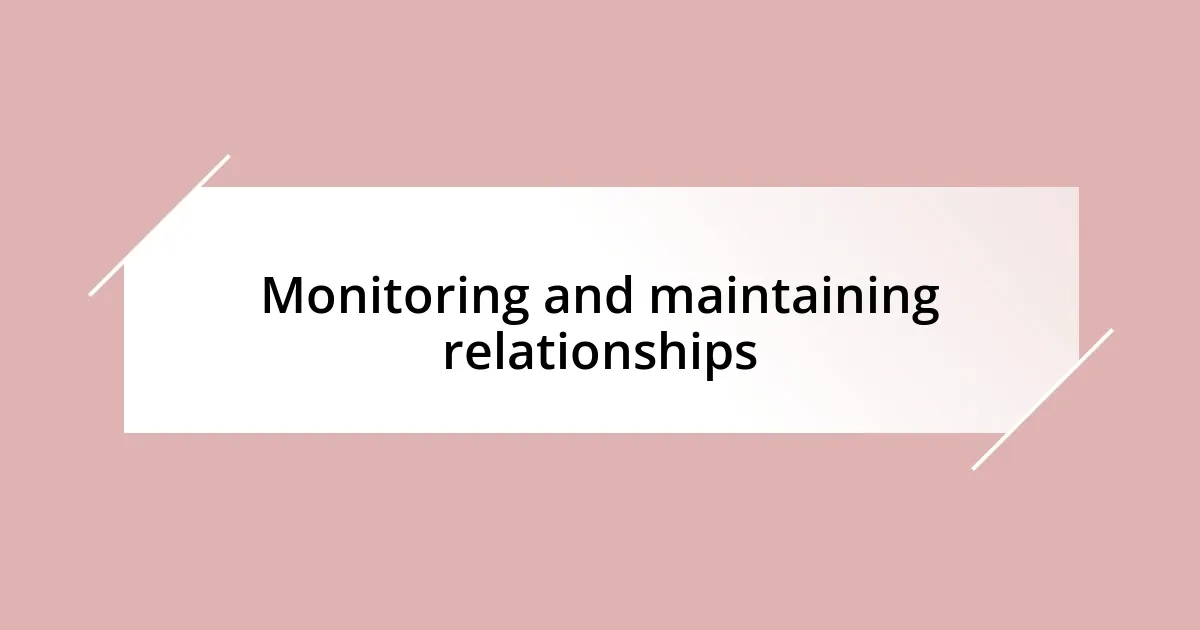Key takeaways:
- Viewing suppliers as allies rather than mere transactions fosters trust and mutual success.
- Regular communication and transparency strengthen relationships and enhance accountability.
- Negotiating win-win agreements through empathy leads to innovative solutions and long-term partnerships.
- Leveraging technology for real-time collaboration improves efficiency and strengthens supplier connections.

Understanding supplier relationships
Supplier relationships are often seen as mere transactions, but I’ve found they can be so much more. When I first started collaborating with my suppliers, I didn’t simply approach them as business partners; I viewed them as allies. This shift in perspective helped me understand their challenges, leading to solutions that benefited both sides. Isn’t it fascinating how empathy can transform a professional relationship?
I vividly remember a time when a supplier faced unexpected delays due to a natural disaster. Rather than rushing to find alternatives, I reached out to see how I could support them. This openness fostered trust, and in return, they went above and beyond to catch up without compromising quality. Have you ever considered how a little kindness could yield immense loyalty in return?
Building strong supplier relationships isn’t just about finding the best price; it’s about creating a foundation built on mutual respect and shared goals. Reflecting on my experiences, I realize that the most successful connections are those where both parties are invested in each other’s success. When you nurture these relationships, you’re not just securing supplies; you’re cultivating a partnership that can weather any storm.

Assessing supplier capabilities
When I assess supplier capabilities, I dive deep into not just what they provide but how they operate. It’s essential to evaluate their reliability, quality standards, and overall efficiency. I recall a specific instance when I partnered with a supplier who boasted low prices. Initially, it seemed like a fantastic deal, but upon closer inspection, there were recurring quality issues that ultimately impacted my business. This experience taught me to look beyond surface-level statistics and truly understand a supplier’s capabilities.
Here are some critical factors to consider while assessing supplier capabilities:
- Production Capacity: Can they meet my demands during peak times?
- Quality Control: What measures do they have in place to ensure consistent quality?
- Supply Chain Stability: Do they have reliable sourcing for their materials?
- Technological Capability: Are they equipped with modern technology to enhance efficiency?
- Financial Stability: Are they in a solid financial position to sustain a long-term partnership?
By focusing on these areas, I’ve developed a more nuanced understanding of my suppliers, ensuring that I choose partners who can truly support my business objectives. It’s been enlightening to realize how much a thorough evaluation can elevate the partnership to new heights.

Building trust and transparency
Building trust with suppliers goes beyond just verbal agreements; it requires consistent actions that reflect your commitment. I remember a point in my career when I made it a priority to share my expectations clearly. I initiated regular check-ins, allowing both sides to express any concerns or insights openly. This proactive approach didn’t just keep us on the same page; it instilled a sense of partnership. Have you ever thought about how much clarity can enhance trust in a relationship?
Transparency is vital as well. I’ll never forget an experience when a project didn’t go as planned. Instead of hiding the challenges we were facing, I decided to be upfront with my supplier. I communicated the reasons behind the issues and worked together to create a resolution. This honesty not only reinforced our relationship but also led to innovative solutions we hadn’t considered before. It taught me that vulnerability can often lead to strength in collaboration.
One of the most rewarding aspects of fostering trust is witnessing how it cultivates accountability. When you build an environment where both parties feel responsible for the outcome, the results can be exceptional. An instance that stands out to me involved a supplier who, due to our open relationship, took full ownership of a mistake and proactively rectified it. This level of accountability deepens the bond and sets a precedent for future interactions. So, how strong is the foundation of trust in your supplier relationships?
| Trust-Building Actions | Effects on Supplier Relationship |
|---|---|
| Regular Communication | Enhances clarity and alignment |
| Honesty in Challenges | Fosters collaborative problem-solving |
| Accountability for Errors | Strengthens mutual respect and reliability |

Effective communication strategies
Effective communication is truly the backbone of any successful supplier relationship. I’ve found that establishing a rhythm of regular communication can make a world of difference. For instance, during a particularly intense project, I set up weekly check-ins with my suppliers. These meetings not only kept everyone aligned but also fostered a sense of camaraderie, allowing us to tackle issues as a team. Have you ever experienced the relief that comes from knowing everyone is on the same page?
Listening actively is another critical strategy I’ve embraced. I remember a time when a supplier suggested a change in the delivery schedule based on their operational constraints. Instead of dismissing it, I took a step back and engaged in a thorough discussion. That simple act of listening turned into a game-changer, as we found a compromise that benefited both parties and ultimately improved our workflow. The emotional connection formed through these conversations can transform challenges into opportunities.
Moreover, utilizing technology as a communication tool has significantly streamlined my interactions. I recently adopted a collaborative platform that allows for real-time updates and feedback. This approach helps eliminate misunderstandings before they escalate. I can’t stress enough how important it is to take advantage of tools that break down barriers and pave the way for transparent, effective dialogue. In your experience, how have you harnessed technology to strengthen your supplier relationships?

Negotiating win-win agreements
Negotiating win-win agreements is about finding common ground that benefits both parties. I recall a situation where I had to renegotiate a contract with a supplier who was struggling to meet their commitments. Instead of demanding penalties, I proposed a revised timeline that allowed them to deliver quality without the stress of an impossible deadline. This approach not only protected our relationship but also led to a more reliable supply chain. Have you ever noticed how a bit of understanding can yield better results in negotiation?
In another instance, I was dealing with a supplier who was hesitant about a pricing adjustment in response to rising raw material costs. Instead of pushing them, I asked open-ended questions that led us to explore alternative solutions. By collaborating to identify ways they could optimize their processes, we achieved a fair price adjustment while ensuring they felt valued and respected. This experience underscored for me how empathetic negotiation can create a shared sense of accomplishment. Have you tried opening discussions with curiosity instead of demands?
I find that putting yourself in the other party’s shoes opens doors to innovative solutions. During a critical negotiation for a large order, I mentioned how their flexibility could help us meet our operational goals. This shift in perspective inspired them to propose a tiered discount structure based on volume, ultimately benefiting us both. As a result, not only did we secure favorable terms, but we also strengthened their commitment to our partnership. How often do you take a moment to consider the perspectives of your suppliers in negotiations?

Monitoring and maintaining relationships
Monitoring and maintaining relationships requires consistent effort and attention. I remember a specific instance when I noticed a decline in one supplier’s responsiveness. Rather than waiting for our next scheduled meeting, I reached out directly to understand their side of things. It turned out they were facing operational challenges I hadn’t been aware of, which allowed me to help them brainstorm solutions. Have you ever thought about how a simple, proactive approach can strengthen the bonds with your suppliers?
Regular feedback is another cornerstone of healthy supplier relationships. I make it a point to schedule performance reviews periodically, where we discuss what’s working and where improvements are needed. I once had an eye-opening conversation during one of these reviews when a supplier revealed they felt unappreciated. By acknowledging their contributions and expressing gratitude, we fostered a renewed commitment on both sides. How often do you check in to ensure your suppliers feel valued?
Moreover, I believe in celebrating successes together. When we achieved a milestone with a significant supplier, I organized a small virtual gathering to mark the occasion. This gesture not only acknowledged their hard work but also reinforced our partnership on a personal level. It’s amazing how little moments can make a lasting impact. Have you considered ways to celebrate your supplier relationships?

Leveraging technology for collaboration
In my experience, technology has been a game-changer for collaboration with suppliers. For instance, I started using project management software to track orders and communicate in real time. I remember when a shipment was delayed; we were able to address the issue immediately through the platform, avoiding a potential crisis. Isn’t it fascinating how real-time communication can create transparency and trust?
I also found that virtual collaboration tools streamline meetings and discussions. Once, during a challenging product development phase, I scheduled a video conference with a supplier team across the country. This face-to-face interaction, despite the distance, fostered a deeper connection, allowing us to brainstorm solutions collaboratively. How often do you utilize technology to bridge gaps and enhance dialogue?
Moreover, I discovered that sharing data through cloud-based systems significantly improves the decision-making process. I recall a situation wherein we shared our inventory levels and sales forecasts with a key supplier. This transparency led to a just-in-time delivery strategy that reduced our lead times significantly. It’s interesting to think about how technology not only simplifies processes but also cultivates a partnership rooted in shared success. How has data collaboration played a role in your supplier relationships?














